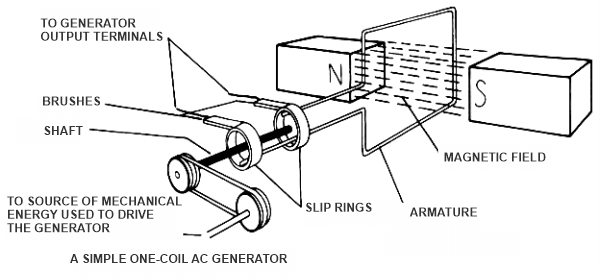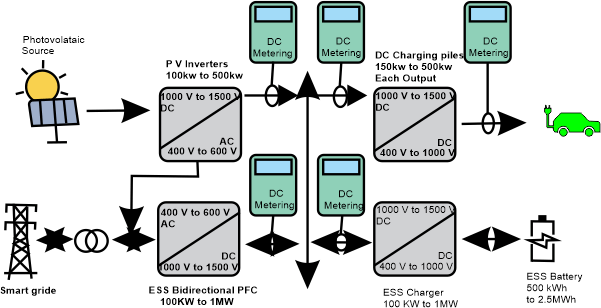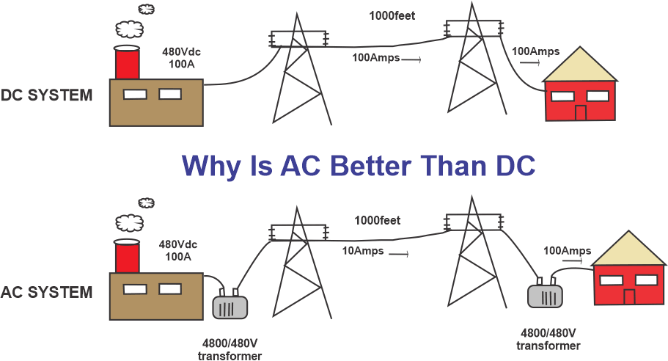Advantages and Disadvantages of A.C. Over D.C.Electric currents may only travel in two directions: Alternating Current (A.C.) and Direct Current (D.C.). However, compared to direct current, A.C. has maintained its dominance. This is mostly because it can easily change its voltage using a transformer to reduce energy losses. The ability of A.C. to transport energy is exceptional, and it is also less expensive, simple, and secure. When A.C. cannot be utilized, D.C. can still be used for energy transfer. Here are some detailed explanations of why A.C. is preferable to D.C. and some drawbacks of D.C. Go on reading! Each one is required at some point, and the other cannot take its place. What are Alternating Current (A.C.) and Direct Current (D.C.)?1. Alternating CurrentThe direction of flow of an electric charge in an alternating current varies from time to time. Alternating Current is the ideal current and is usually used in homes, companies, etc. Firstly, it was tested using a Dynamo Electric Generator based on Michael Faraday's principle in 1832. Alternating Current is in the form of a wave, known as a sinusoidal wave or simply a sine wave which is a continuous and smooth wave. A.C. is easier to flow over long distances. Hertz (Hz) is the measurement unit of A.C. In every home and office; we found only that A.C. is used in the oven, mixer grinder, and refrigerator. 
An Alternate current is characterized as one whose magnitude and polarity fluctuate regularly. In contrast to Direct Current, or D.C., which constantly runs in a single direction, it can be described as an electrical current that frequently changes or reverses its direction. Principle of AC Current An alternator is a device that is used to generate alternating currents. It is an electric generator which is a very unique and different type of generator used to create alternating currents. A device called an alternator is used to produce alternating currents. It is a unique and different type of electric generator that is designed to produce alternating currents. A loop of wire is used, which is spun inside a magnetic field to create current along the loop; because the wire spins and periodically enters the magnetic polarity, producing alternating voltage and current, the wire can be turned using any method. It is possible to use the water analogy to compare the process of creating an Alternating Current. A mechanical crank is connected with the piston connected to a set of water pipes to create an alternating current (A.C.). This causes the water to travel back and forth in the pipes, mimicking the periodic charge changes in an A.C. Applications A.C. outlets are virtually usually utilized in homes and offices. This is due to the ease with which A.C. may be generated and transmitted across long distances. Less energy is lost in transmitting electrical power at high voltages, such as those exceeding 110kV. Higher voltages result in lower currents, and lower currents result in less heat produced by resistance in the power line. Transformers make the conversion from high voltages to A.C. simple. A.C. may also power electric motors. A motor and a generator vary only because a motor converts electrical energy into mechanical energy. 
The filter (Filter) in the wave rectifier (rectifier) circuit serves to achieve a flat unidirectional output voltage from the rectifier circuit. The goal of rectification is to generate direct current. We don't obtain pure direct current from a rectifier but rather a changing periodic current. Hence this direct current incorporates an alternating current component. Voltage ripple refers to this change in voltage. The voltage ripple in a full-wave rectifier is less than that in a half-wave rectifier. To further reduce voltage ripple, a filter passes the unidirectional component while prohibiting alternating components. 2. Direct CurrentWe can say that the electrochemical cell is the main example of D.C. or power. One thing that distinguishes between A.C. and D.C. is that D.C. may flow through a conductor, semiconductor, and insulator as electrons move in one direction from the negative end to the positive end of the battery. The current which flows in one direction only is known as Direct Current. D.C. is also called galvanic current. Direct-current electrical energy is required for the electrochemical processes used in smelting aluminum and other materials. Additionally known as galvanic current, D.C. Direct current has several uses, such as battery charging and large power sources for electronics, motors, and other devices. Additionally, certain trains use it, especially in urban areas. High-voltage direct current connects alternating current power grids and transmits substantial amounts of electricity from far-off producing facilities. 
Application of D.C.'s currentResidential and commercial structures Numerous electrical equipment that uses or generates direct current use this sign, represented by the Unicode character U+2393 (). D.C. is widely used in various low-voltage and extra-low-voltage applications, especially those powered by batteries or solar energy (since both can produce only D.C.). The majority of electronic circuits need a D.C. power source. Unless the appliance contains a diode bridge to account for this, it is often crucial when using a D.C. appliance to observe polarity. The open industry group EMerge Alliance is creating standards for distributing D.C. electricity in commercial buildings and hybrid homes. Automobiles DC is used in the majority of automotive applications. An automobile battery powers the ignition system, lights, temperature controls, and infotainment system. A rectifier is used by the alternator, an A.C. device, to create D.C. for battery charging. The majority of highway passenger vehicles use 12 V systems. Many diesel-powered large vehicles, farm machinery, and earthmoving equipment use 24-volt systems. The sockets, connections, switches, and fixtures used in domestic D.C. installations often differ from those used in alternating current installations. This is mostly because more currents are required to deliver the same electricity at lower voltages. Telecommunication Standard 48 V DC power supplies are used for communication equipment in telephone exchanges. A battery system is used in telephone systems to guarantee that subscriber lines will always have electricity. The battery bank's positive terminal and the power supply system's positive terminal are grounded to establish the negative polarity. To avoid electrolytic deposits, this is done. Using a DC-DC converter, other devices may be powered from the communications D.C. system at any reasonable voltage. Many telephones that connect to twisted pairs of wires employ bias tees to internally separate the A.C. component of the voltage between the two wires (the audio signal) from the D.C. component of the voltage between the two wires (used to power the phone). High-Voltage Electricity Transmission High-voltage direct current (HVDC) electric power transmission systems use D.C. for the bulk of the electrical power transfer as opposed to the more common alternating current systems. HVDC systems may be less costly and have less electrical loss for long-distance transmission. Difference Between A.C. and D.C.Direct current (D.C.) only travels in one direction through a wire, or forward, as its name would imply. D.C. is either dotted or straight and has both plus and minus signs. It is used to power electronic equipment like mobile phones, flat-screen televisions, electric cars, and more while also charging batteries. In other words, D.C. is required for anything that draws power from a battery, USB cords, or an A.C. converter plugged into a wall outlet. A.C. is the chosen conventional electric power for companies and homes worldwide. Depending on the country's electric grid, it changes the order 50 to 60 times every second. On the other hand, A.C. continuously moves forward and backward, changing direction. Advantages of A.C. over D.C.

Disadvantages of A.C. over D.C.The fact that A.C. is the greatest option does not imply that it offers everything. The following are some downsides of this sort of current:
Alternating Current or Direct Current, which is Riskier?The A.C. is said to be five times more dangerous than D.C. The fundamental cause of the severe impacts on human bodies is the high frequency of A.C. It has a frequency of sixty circles, which is quite destructive. It is important to note that even a low frequency of roughly 25 volts might kill you. This demonstrates how deadly A.C. may be if not handled with extreme caution. A.C. induces intense muscular contractions and sweating, which minimizes skin resistance. If a person is directly exposed to A.C., it is best to remove them from the situation as quickly as possible to avoid serious injury or death. Which is Better, A.C. or D.C.?People worldwide prefer and are acclimated to A.C. rather than D.C. A.C. is preferred because of its capacity to transport high voltages over long distances, reduced power loss during transmission, and a cheaper, safer, and more pleasant method of generating and converting current to D.C. However, D.C. remains significant because of its low consumption voltage in airplane applications and other particular uses where A.C. cannot be utilized. Your requirements and application will thus determine the best one. 
Can A.C. Appliances be Powered by D.C.?Most domestic and workplace appliances, such as washing machines, fans, mixers, light bulbs, and air conditioners, operate only on alternating current (A.C.). D.C. powers some A.C. appliances. It all depends on the equipment you have because other items require just an A.C. power and will break down or stop working if a D.C. source is utilized. Some devices, such as laptops and mobile phones, operate on D.C. converted from an alternating current supply through an A.C. converter or USB cords. As a result, before connecting your equipment to A.C. or D.C. power transmitters, it is best to study the description of your appliance. Why Is AC Less Expensive Than DCBecause transformers are used to distribute electric current, which enormous power plants often produce, A.C. is far less expensive than D.C. Since there are fewer energy losses throughout creation, especially when distributing power over great distances, it becomes less expensive. The transformer may transfer a high voltage into a low voltage appropriate for home electronics like lights and refrigerators. Furthermore, unlike the reverse, which cannot be done, power may be converted to D.C. as necessary. ConclusionThere was initial disagreement on whether standardizing the electrical utility industry with ac power or dc power was preferable. Alternating current power has outperformed direct current power due to various benefits. The conversion of voltage levels in ac power enables the production of electrical power at low voltage, followed by steps up and down to decrease I 2 R losses during long-distance transmission and distribution, respectively. A transformer is used to achieve this voltage by stepping up and down. Everybody chooses the most straightforward way to transfer electricity that is inexpensive and efficient, and A.C. provides that. Even if D.C. voltage is gradually improving its inefficiency for long-distance power delivery, more is still required for a realistic outcome. It is nearly hard to go from A.C. voltages to D.C. voltages. However, each has a certain use, so you should choose one based on what you want to use it for. |
 For Videos Join Our Youtube Channel: Join Now
For Videos Join Our Youtube Channel: Join Now
Feedback
- Send your Feedback to [email protected]
Help Others, Please Share










